Blog
9.292017
Chemistry & mushroom, special mushroom report
Today:4views / Total:4,249views Written by: 久田智也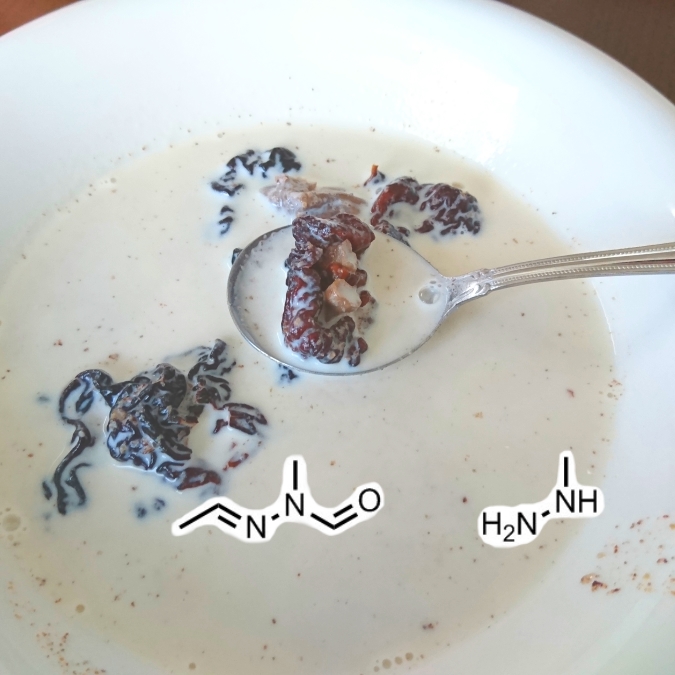
How are you all in this cold weather? This is Hisada of B4.
The autumn sun is called a fishing bottle drop or it seems that it gets darker day by day. Temperature at night is getting lower and so take good care of your health.
In Autumn, many fruits and delicious delicacies are in season and we can enjoy delicious food. Do you remember the food that you ate in last Autumn?
There are sword fish, salmon, grapes, pears, salmon, sweet potatoes and chestnuts. Bonito season is twice a year and now is the season when the bonito is produced.
Maybe because its Autumn, some people might remember that mushroom is growing well in this weather.
So let me tell you my hobby which is mushroom and my interest in chemistry.
As for mushrooms, everyone will be reminded of shiitake, nameko, enoki, shimeji, eringi, maitake. Many of these mushrooms lined up in supermarkets and department stores are grown artificially (excluding matsutake). However, there are many more types of mushrooms in the world, including poisonous mushrooms and delicious ones.
My hobby is looking for mushrooms that grow in the mountains and take pictures of them (sometimes I eat and taste it).
I have taken more than 1000 photos so far but I will show you only a few of them (identification of mushrooms is not guaranteed).
- テングタケ、有名な毒きのこ
- ムラサキホウキタケ、食べたことないけど可食
- アカヤマドリ、食べたことないけど可食
- クロラッパタケ、食感がいい
- タマゴタケ、うまみがあってとてもおいしい
- ロクショウグサレキン、青くて綺麗だけど食不適
- チチタケ、栃木では結構食べるらしい
- アミガサタケ、見た目と食感が面白い
- シロタマゴテングタケ、極めて致死的な毒きのこ
There are many mushrooms with different colors and shapes in the food department and you will notice that there are a wide variety of mushrooms. What is interesting (for me) is the compounds that is found in the mushrooms.
For example, the agaric on the upper left in the image above contains an amino acid called ibotenic acid.

↑イボテン酸(左)とムッシモール(右)
Ibotenic acid is an amino acid that does not produce protein and resembles the major stimulatory brain neurotransmitters glutamic acid (glutamate). It seems to have very strong taste when ingested.
However, this Ibotenic acid and Muscimol, a decarboxylated compound are both neurotoxic so agaric is not edible.
In addition, the blue pigment of Rokushogusarekin in the middle right is called xylindane.
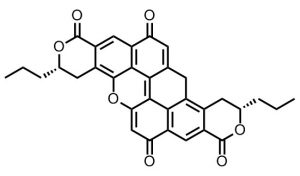
↑キシリンデイン
It seems that dyeing can be done with this Rokushosakin dye.
Furthermore, the toxic component of white agaric mushroom in the lower right image is a group of cyclic peptides collectively called amatoxins, with α-amanitin being well known.
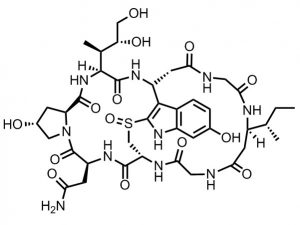
↑α-アマニチン
α-Amanitin inhibits mRNA synthesis and exerts toxicity by making it impossible to synthesize proteins necessary for survival. Because it is extremely toxic and has no antidote, poison caused by mushrooms causes severe symptoms and deaths are also known.
Of course, mushrooms contain not only poisons and pigments but also ingredients such as 5′-guanylic acid which are abundant in shiitake mushrooms, 1-octen-3-ol, which is an aroma component of matsutake and fly agaric. A wide range of compounds including vanadium and amabadine. And I was interested in these ingredients at the beginning of my chemistry (although I didn’t even know chemistry at that time). When I was in the first grade of elementary school, I still don’t know what was the structural formula of the mushroom in the mushroom picture book means. I still remember that it was the beginning of everything that I asked my parents.
(I don’t remember) I seem to have gain strong interest in mushrooms before I become a primary school student and it could be because my parents bought a mushroom picture book. There are still many books about mushrooms in my room. I have read these books since I was little so I still remember location of the mushrooms but there was a description that I had always been interested in. It is a description of a mushroom called Sagma Amiga Satake.
Sagma mushroom is a brown to dark brown mushroom shaped like a brain and is a spring mushroom closely related to the mushroom mushroom in the photo above. This mushroom contains a component called guillomitrin which becomes monomethylhydrazine when hydrolyzed in the body.

↑ギロミトリン(左)とモノメチルヒドラジン(右)
These are known to be very toxic and carcinogenic but not very likely to eat stag beetle.
However, the scientific name of Shagma Amiga Satake means “eatable” in Latin. In fact, these toxic substances found in Scandanivia are easily soluble in water and volatilize so boiled swordfish can be eaten if boiled and detoxified. However, every book states that “stag beetle is highly toxic and must be eaten because boiled steam poisoning is known.”
However, if people in Scandinavia eat such poisonous foods while knowing the risk of poisoning due to steam, they will be confused that it is very delicious. Is it because it is a Japanese puffer? The puffer fish eats and then he lives.
Finally, an opportunity came for me. My mother who loves travelling abroad went to Finland for a trip. Then, I made an unreasonable request here.
“Can you please buy shagama mushrooms as a souvenir.”
After 10 days of travelling, I’ve received an email from my mother.
“I don’t know if it is the right one but I bought a mushroom.”
I didn’t expect much at first but when I looked at the real thing, I wasn’t very surprised.
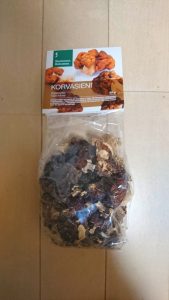
「これだ」
It is a dried product of Sagma mushroom and looks toxic. It clearly states that it is a poisonous mushroom on the back. Thankful to my mother.
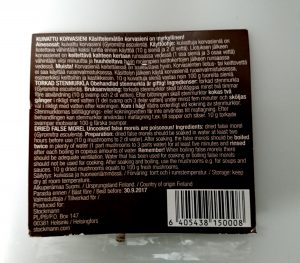
Instructions were written clearly and the treatment method in multiple languages. First, boil the mushroom twice after soaking in water and wash them every time it is boiled. Do not use boiled juice for cooking and cook in a well-ventilated place.
In fact, the poisonous component of this mushroom is volatile as I mentioned earlier so it is said that it has decreased considerably when dried.
Let’s cook according to the explanation immediately.
- 水に浸した後……
- 2回ゆでる!
Already boiled mushroom.
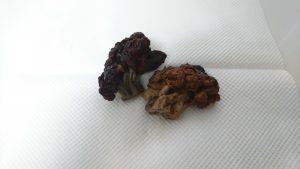
It is not as it seems it is…….
However, I’ve been looking forward to this moment for years but I can’t afford to eat here.
I don’t know how to eat it so I decided to make it like a potage.
- 大粒のものを別にとっておき……
- 残りはミキサーにかける
- 生クリームと牛乳を入れて……
- 大粒のものをいれて完成(?)
Aside from being very rough, the completion of the Shagma Amiga Satake Potage (?).
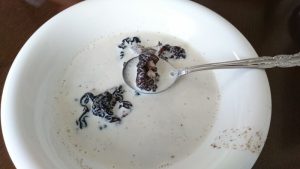 Ohhh……
Ohhh……
Thanks for the meal. Man, this taste very bad but it is my last supper.
Well, not so bad.
Although the taste is not strong, it is close to shiitake mushroom and the texture is not as crispy as jellyfish. It is plentiful and the fragrance is rich in wild mushroom-like taste (it usually goes with Italian food etc. High-quality mushrooms, close to boletus).
umum……mogumogu……Jaritsu!!
?!
When you eat large mushrooms, you teeth will feel weird. Apparently, this seems to be the sand that was taken inside when the stag beetle grows (the head part of the stag beetle is hollow, and it is easy for sand to enter it). Properly, the Finnish version of Wikipedia says that you should eat after removing the sand.
…... I don’t know that! At least it is not written on the Japanese version of Wikipedia. It is not on the pictorial book. It was not written in the guide.
But in this way, I got information that I couldn’t easily find on the picture book or on the internet. And also about the taste of shagma mushroom.
I don’t know if it’s worth eating. It’s not delicious enough to flip so it’s not worth it. However, if it was easy to eat like this and I would like to eat again. Next time I’ll wash away the sand and eat it.
That’s why it’s been quite long, but that’s all for my mushroom story and the poisoned poison mushroom repo.
My story is quite long but that is all for my mushroom story. However, I would be pleased if there is anyone interested in mushrooms from a chemistry perspective or other perspectives. I would like to write a mushroom story again if there is a chance someday but I am thinking about a different story for now.
The contents were completely unrelated to the laboratory but please look forward to my next blog! Thank you very much.
久田智也
最新記事 by 久田智也 (全て見る)
- (日本語) きれいで化学な贈り物。鉱物なんていかがですか。 - 2018年1月27日
- Why do not you start a life with fruit wine? - 2017年11月29日
- Chemistry & mushroom, special mushroom report - 2017年9月29日
Comment
-
December 31st, 2017Trackback from : 研究・アウトリーチアワード2017発表 | 山口潤一郎研究室


 日本語
日本語 中文
中文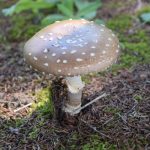
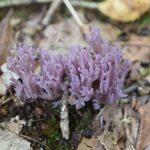
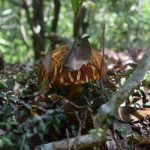
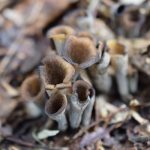
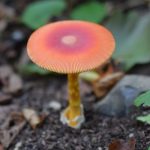
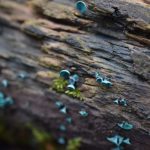
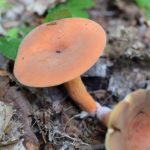
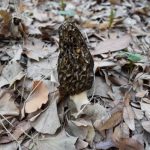
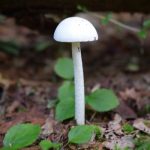
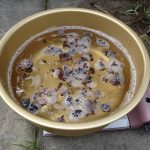
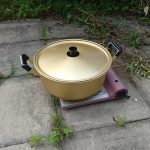
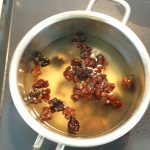
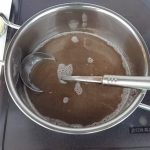
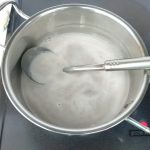
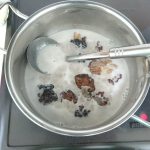







































私は東京に住んでおりますが、仕事を辞めてからは年間250日くらい山梨県の富士山麓の鳴沢村に来ております。
山菜やキノコを採取したり、また山菜やキノコの栽培に挑戦したりして独りで楽しんでいるものです。
胃がんで3/4を切除しており、都会より山の中で良い空気を吸って、ストレスをためないような生活をしたいと思ってこんな生活を始めました。
。
シャグマの記事を読ませていただき、びっくりいたしましたまさか食べる方法があったとは知りませんでした。
今日はシイタケを採取に栽培地に行きましたらシャグマアミガサダケが数本生えておりました気持ちが悪かったので棒でたたいてつぶしてきました。
実は昨年アミガサタケの老体をミキサーでつぶして、水で薄めたものを山中にまいてみました、もしかしたらアミガサダケが発生するかもしれないと思ったのですが1本も生えていませんでした。ハナイグチはこの方法でキノコの発生例があるみたいです。
栽培をしているキノコはシイタケ、ナメコ、クリタケ、ヒラタケ、ムキタケ、マイタケ、ハタケシメジ、ムラサキシメジ等で、自然に生えてくるキノコはタマゴタケ、ナラタケ、ハナイグチ、ハナビラタケ等です。、
話は変わりますが房総半島で鴨川から内陸に入ったあたりに、東大の演習林があり清澄山あたりでコウタケという大変おいしいキノコが発生するという話を聞きましたので、どんなところかと思って1月に友人と3人で様子を見に行ってきましたが、狭い道路であまり走りたくないようなところでした。
今度は演習林のコウタケの採取や炊き込みご飯の話をお願いいたします。